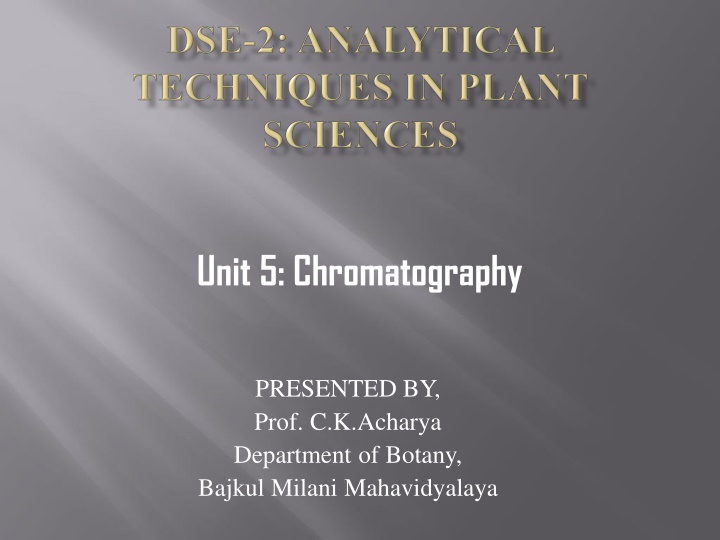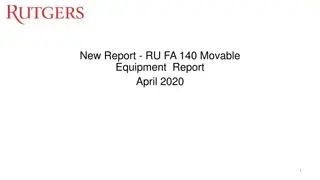
Chromatography Technique: Column Chromatography Explained
Learn about column chromatography, a technique used to separate substances based on their affinity for an adsorbent and solvent mixture. Understand the process, preparation of the column, sample introduction, elution techniques, and component detection. Enhance your knowledge of this solid-liquid separation method.
Download Presentation

Please find below an Image/Link to download the presentation.
The content on the website is provided AS IS for your information and personal use only. It may not be sold, licensed, or shared on other websites without obtaining consent from the author. If you encounter any issues during the download, it is possible that the publisher has removed the file from their server.
You are allowed to download the files provided on this website for personal or commercial use, subject to the condition that they are used lawfully. All files are the property of their respective owners.
The content on the website is provided AS IS for your information and personal use only. It may not be sold, licensed, or shared on other websites without obtaining consent from the author.
E N D
Presentation Transcript
Unit 5: Chromatography PRESENTED BY, Prof. C.K.Acharya Department of Botany, Bajkul Milani Mahavidyalaya
Column chromatography is a technique in which the substances to be separated are introduced onto the top of a column packed with an adsorbent, passed through the column at different rates that depend on the affinity of each substance for the adsorbent and for the solvent or solvent mixture, and are usually collected in solution as they pass from the column at different times. It is a solid-liquid technique in which the stationary phase is a solid & the mobile phase is a liquid or gas. It was developed by the American chemist D.T Day in 1900 while M.S. Tswett, the Polish botanist, 1906 used adsorption columns in his investigations of plant pigments.
In column chromatography the stationary phase is packed into a glass or metal column. The mixture of analytes is then applied and the mobile phase, commonly referred to as the eluent, is passed through the column either by use of a pumping system or applied gas pressure. The stationary phase is either coated onto discrete small particles (the matrix) and packed into the column or applied as a thin film to the inside wall of the column. As the eluent flows through the column the analytes separate on the basis of their distribution coefficients and emerge individually in the eluate as it leaves the column.
A. Preparation of the Column The column mostly consists of a glass tube packed with a suitable stationary phase. A glass wool/cotton wool or an asbestos pad is placed at the botton of the column before packing the stationary phase. After packing, a paper disc kept on the top, so that the stationary layer is not disturbed during the introduction of sample or mobile phase. There are two types of preparing the column, they are: 1. Dry packing / dry filling In this the required quantity of adsorbent is poured as fine dry powder in the column and the solvent is allowed to flow through the column till equilibrium is reached. 2. Wet packing / wet filling In this, the slurry of adsorbent with the mobile phase is prepared and is poured into the column. It is considered as the ideal technique for packing. Before using column, it should be washed properly and dried. The column should also be free from impurity and uniformly filled with the stationary phase. B. Introduction of the Sample The sample which is usually a mixture of components is dissolved in minimum quantity of the mobile phase. The entire sample is introduced into the column at once and get adsorbed on the top portion of the column. From this zone, individual sample can be separated by a process of elution. C. Elution By elution technique, the individual components are separated out from the column. It can be achieved by two techniques: Isocratic elution technique: Same solvent composition or solvent of same polarity is used throughout the process of separation. Eg. Use of chloroform alone. Gradient elution technique: Solvents of gradually polarity or elution strength are used during the process of separation. E.g. initially benzene, then chloroform, then ethyl acetate then chloroform D. Detection of Components If the compounds separated in a column chromatography procedure are colored, the progress of the separation can simply be monitored visually. If the compounds to be isolated from column chromatography are colorless. In this case, small fractions of the eluent are collected sequentially in labelled tubes and the composition of each fraction is analyzed by TLC.
Column chromatography is one of the most useful methods for the separation and purification of both solids and liquids. Its major application includes: Separation of mixture of compounds. Removal of impurities or purification process. Isolation of active constituents. Isolation of metabolites from biological fluids. Estimation of drugs in formulation or crude extracts.





